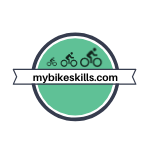Practice, Glide and Pedals On
Now, that the pedals are off and the seat is low enough, make your way to your local playground, schoolyard, or car-free space. It can help if the space you choose has a very slight downhill as it is easier to balance and glide with a little bit of additional speed.
Tips for practice:
1) Encourage the rider to stay in contact with the seat vs. walking with the bike and not sitting on the seat. Take snack or play breaks to keep the practice fun. The rider may also complain about the bike seat hurting their bottom. This is normal and will decrease once they are pedaling and supporting their body weight through pedaling as well. And, some bike seats can be very uncomfortable so you might consider changing the seat or adding a padded cover later on if it continues to be an issue.
2) Encourage the rider to sit up tall while practicing instead of slouching backward.
3) Encourage the rider to continue to look forward and relax their arms while practicing.
I will take a while for the rider to integrate the new sensations and experiences while they are learning to glide. It may seem like it is taking much longer than it should, however, this is normal. Once the new movements are integrated, gliding and pedaling follow quickly. It is common for the learning to glide phase to take up to 3 hours, so be patient and set up a number of practice sessions.
There is a drill at 1:36 in this video that I encourage you try. It will help the rider relax enough to notice they are leaning and begin to turn their handlebars slightly into the direction that the bike is leaning. The action of turning into a lean while riding brings the bicycle back upright and allows continued forward motion. A big part of learning to balance a bike is making this kinesthetic understanding automatic through continued practice.
Continue your practice until the rider can glide with their feet up for at least 10 seconds and completed their glide with a turn to both the left or the right. This is an exciting moment as they are ready to “earn their pedals”. If your child is anxious to get their pedals before they are able to glide, be aware that they will not be able to ride until they can glide. This is another opportunity to highlight being proud of the effort they are putting into the process of learning instead of the outcome of independent pedaling. I encourage you to hold the limit / expectation that they glide for 10 seconds before getting their pedals. Doing otherwise is usually counterproductive and does not lead to further progress.
Congratulations, they are gliding for 10 seconds or more.
At this point it is time to get the pedals back on. The tips for putting pedals back on are at 2:32 in the video above and the drill for preparing them to transition from gliding to pedaling is at 3:19. Since making that video, I have added the prompt to take a deep breath as they start to glide, then find their pedals (without looking down) and as they breathe out start to pedal. Incorporating breath into this transition helps to keep riders more relaxed and successful. Now is a good time to get your camera out and witness your rider put it all together.
And, if it doesn’t all happen in this one session, that is ok too. You have the skills, knowledge, and resources to support them in riding in the next or following sessions. Celebrate their progress and focus on learning something new.
And make some room in your schedule for more ride and/or practice time.
You may already have an idea of your next bike outings or friends and family that may be able to join you for new adventures.
You and your rider have just successfully, or soon will have accomplished an incredible rite of passage.
Now, it’s time to celebrate.
CELEBRATE
CELEBRATE
Here is a downloadable certificate for you and your rider.


